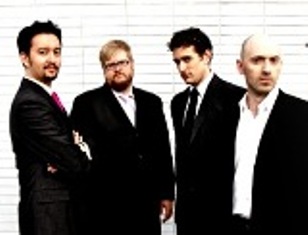
New York Polyphony
|
Review by Thom Mariner
As if necessary, countertenor Geoffrey Williams of vocal quartet New York Polyphony, reminded the audience that this concert was not typical of the holiday music that surrounds us wherever we go during this busy season. One only wishes it could be… No "Jingle Bell Rock" or "Rockin' Around the Christmas Tree" here; instead, a time bending tour through mystic Christmases of 500-800 years ago.
New York Polyphony (NYP) is a relatively new player on the classical music scene, having joined forces in 2007. Comprised of Williams, tenor Geoffrey Silver, baritone Christopher Herbert and bass Craig Phillips, NYP has to this point focused its energies primarily on male quartet music of the Medieval and Renaissance periods, prior to 1600. They performed Friday, December 17, at St. Peter in Chains Cathedral in downtown Cincinnati as part of its “Great Music in a Great Space” series. The group has leapt to prominence as a result of its second recording, “Tudor City,” which received rave reviews both here and abroad, and climbed to No. 6 on the Billboard classical chart this past summer.
As a means of easing our time-travel to half a millennium hence, the concert opened with a modern musical invitation to the Christ child by Oslo-based English composer Andrew Smith, who has written a number of works for NYP that evoke ancient times while standing clearly in the 21st century. "Veni Redemptor Gentium" (which opens their debut recording, "I sing the birth," from 2007) prepared our ears with its opening and closing unison chant, spotlighting straight away the hallmark of this ensemble: four voices working and sounding as one.
The image that kept coming back to me throughout this performance was of vocal nesting dolls, in which each voice is a replica of the others, only with higher or lower frequencies that fit neatly within the more meaningful whole. Never have I heard a group in which everything is approached with such a singular purpose. Breathing, phrasing, articulation, vowel shape…all were aligned as if this group grew up in the same choir school.
The foundation of the group's sound is undoubtedly the rich, supple bass of Phillips, who provides a sumptuous vocal cushion allowing the upper voices to explore their own lines with relish and aplomb. He introduced the group at the outset and pointed up his tenure here in the 1990s as a grad student at CCM and member of former a cappella group, VoiceBox, which was represented by several former members in the audience. Tenor Silver and Baritone Herbert sing together beautifully as if musical brothers; at times their sound is nearly indistinguishable. And Williams possesses one of the simplest, least-affected countertenor voices ever heard. The whole vocal package is quite exquisite and enhanced by their prodigious musicality.
Throughout, the quartet communicated beautifully internally and with the audience. Each member of the ensemble spoke at some point during the program, and these intros gave the audience a brief look beyond the voices and into the personalities of these singers. Much of this music is fairly esoteric, but background information was delivered casually with charm and wit, adding to the overall pleasure of the experience.
The program was a mix of selections from NYP’s two recordings, as well as repertoire from the Flemish Renaissance that is slated for a future project. Ranging from 1300 to the early 1500s, this music traversed from stark chiseled phrases moving in parallel to complex, soaring lines weaving together harmonies as if by chance. Also, two of the singers displayed their promising compositional and arranging skills, with Williams’ lovely setting of the ancient text “Adam lay ybounden” and Phillips’ fascinating arrangements of Irish melody “The darkest midnight in December” and “Away in a manger.”
Other points of interest were the frequent shifting of forces from quartet to duo and trio, and the way NYP quickly learned to “play” the idiosyncratic St. Peter in Chains space. Ends of phrases were shaped to either make the most of or to compensate for the opulent acoustic. For the opening of the second half, Silver placed himself in the rear choir loft exchanging solo lines overhead with the remaining trio still at the front. The effect was amazing.
Quibbles? Only a few… There were times when it would have been preferable to have a bit more sound from tenor and baritone, but this is more likely a factor of the acoustics than an ongoing balance issue. The St. Peter in Chains space seemed to enhance especially Phillips’ resonant bass.
A lot of this music tends to be medium in its dynamic range. It was only in the final piece – “Ave Maris Stella,” another contemporary work by Andrew Smith – that we heard a true, full-throated “forte.” It was thrilling, but we could have used more at both ends of the emotional spectrum.
As good as their communication was, having at least some of this music memorized would serve to enhance the listener experience that much more. Hopefully, this will be something they incorporate as they continue to perform together.
Major kudos go to St. Peter in Chains and music director, Tony DiCello, for their ongoing choral series, and for taking a chance on an emerging ensemble like NYP. It’s a an obvious choice to bring back Chanticleer (coming March 11) and other established groups on a regular basis, but presenting a relative newcomer takes a commitment to the art form that is much appreciated. Visit www.stpeterinchainscathedral.org for a complete schedule.
To learn more about NYP or to sample their music making, visit www.newyorkpolyphony.com.